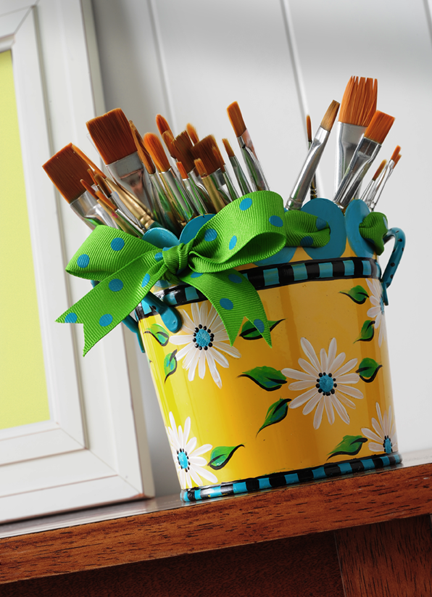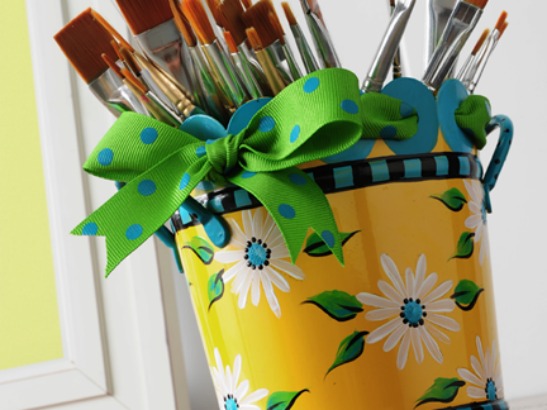

Did you know that painting on metal is often referred to as "tole painting" As a matter of fact, the word "tole" is a French word meaning hand-enameled tinware which often is embellished with gold gilding. Tole painting of years gone by is found on metal surfaces such as pitchers, coffee pots, spice jars, drinking vessels, canister sets and documents boxes of all sizes and shapes.
The art of tole painting was often studied in schools; and then apprenticed for many years before becoming a successful commercial tole painter! The medium of choice was oil paints and familiar brush strokes such as the "comma" and "s" stroke were practiced for hours. Here in the US, the art of tole painting began in the 18th century in New England states and continued with German immigrants in Pennsylvania.

Today tin is still a great surface to paint on and modern painting is enjoyed with fun, vibrant, long-lasting acrylic paints. The key to painting on tinware is to properly prepare the surface so that your artwork will last for many generations to come! So, let's talk about preparing tinware.
The first thing we must talk about is whether your project surface is new or old metal. Preparing new tinware is as simple as properly cleaning, drying and priming. Preparing older tinware can be trickier as rust and corrosion may have accumulated over the years.
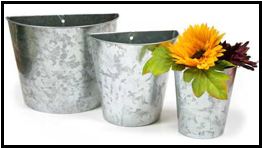
How to Prepare "New" Tinware --
1. Begin by removing price stickers; wash in warm soapy water, rinse with clean water and dry thoroughly.
2. Tinware should be wiped down with white vinegar dampened cloth to neutralize the surface and remove remaining grease or soap film.

3. Because tinware usually has seams or "rolled" hems, a hair dryer may help drying. You can also place your clean tinware in a warm oven for 30 minutes to completely dry all areas.
4. Next, tinware should be lightly sanded in a circular motion with either fine grit sandpaper or steel wool to give your surface "tooth" for better paint adhesion; remove sanding dust.
5. To prevent rust from happening in the future, it is always a good idea to prepare tin with a metal primer. You can either brush-on or spray metal primer.
6. When thoroughly dry, begin painting base color using FolkAt Acrylics; using a soft bristle brush and light pressure to reduce brush marks. I usually apply a couple coats of color allowing ample drying time between applications. (Or you may use a commercial spray paint.)
7. Now you are ready to decorate your tin surface by painting or stenciling.
8. And remember, tinware is easily scratched. When your painting is dry, I recommend sealing your artwork with a couple coats of either brush-on FolkArt Artists Varnish (Matte, Satin or Gloss) or spray FolkArt Clear Acrylic Sealer.
How to Prepare "Old" Tinware --
1. First and foremost rust should be removed from old tinware because left alone, rust will continue to "grow." Remove all signs of rust using a wire bristle brush and/or medium grit sandpaper working in a circular motion.
2. Wash old tin in soap and water to remove dirt, grease and grime. Rinse well with clean water and allow to thoroughly dry.
3. Continue preparing old tin following steps 2 - 8 as mentioned above.
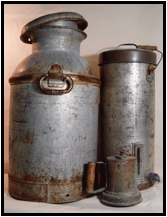
Now let's have some fun .... I will share a project painted on the best kind of tin ... one that is new, clean, and already primed and painted a fun bright yellow. I used FolkArt Enamels, however, you could easily use FolkArt Multi-Surface Paints as well.
Supplies:
FolkArt Enamels: Wicker White, Licorice, Calypso Sky, Lime Green and Aqua
Miscellaneous: Brush Basin or container for water, paper towels, foam plate, pencil, circle template, No. 8 Flat brush and No. 1 Liner brush, 1/4" dauber, ribbon, graphite or transfer paper, stylus and tracing paper.
You can see in the pic below I created a rough sketch of what I was going for.
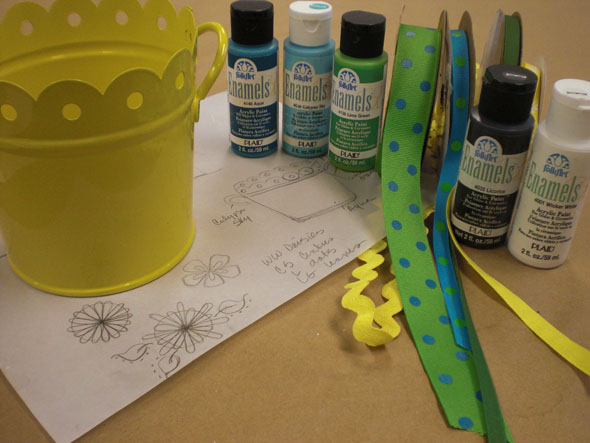
I wanted to accent the scalloped edge of the pail, so I lined up my Fiskars circle template and traced a pencil line directly onto the metal pail.
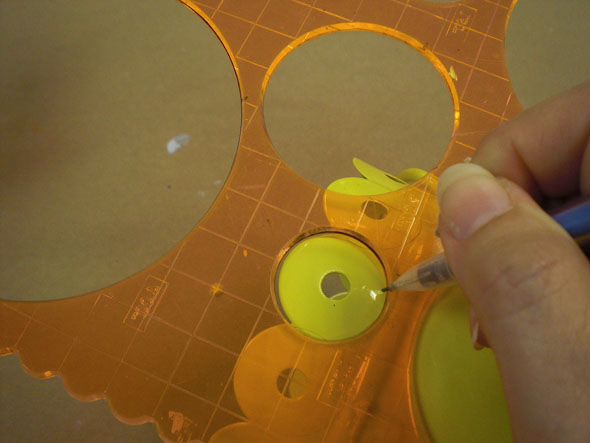
I had decided to paint daisies with alternating long and short petals. Here is a new trick to creating them ... still using my circle template, I traced a 1" circle and marked the center. I then lined up and traced a 2" circle. Once you have two circles completed, begin drawing simple daisy petals at 12, 3, 6, and 9 o'clock using the outer circle as your guide; then fill in between each petal with another long one (8 petals total). Next, using the smaller circle as a guide, draw shorter petals filling in between each long petal.
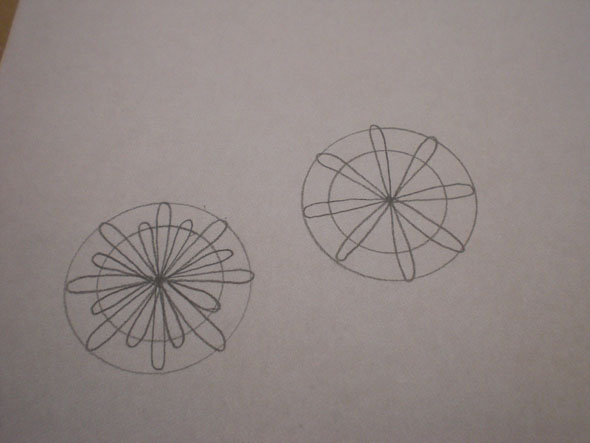
I then created a tracing paper pattern of daisies and simple leaves, slipped transfer paper between the pail and pattern and traced the daisy and leaf pattern using a stylus.
Now the real fun begins! The top scalloped edge of circles was painted alternating Aqua and Calypso Sky. I also painted the top horizontal band Calypso Sky and the bottom band and handles Aqua.
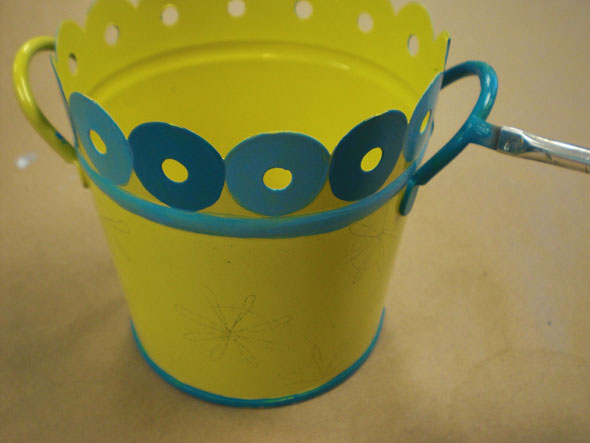
I next painted Wicker White daisies; starting with the long petals and then filled in with the short petals. Every stroke begins at the petal tip and is stroked toward the center.
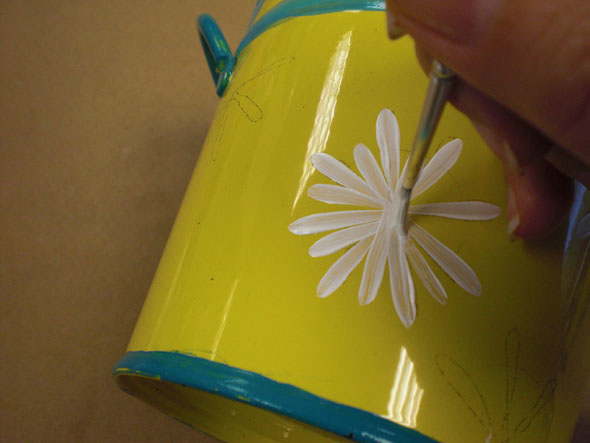
To paint the daisy centers, I loaded a 1/4" dauber with Calypso Sky and dotted the center. I also added a touch of Aqua at the base of each daisy center. Paint a few Lime Green leaves around the painted daisies. NOTE: I painted one leaf on the right and two to the left of each daisy.
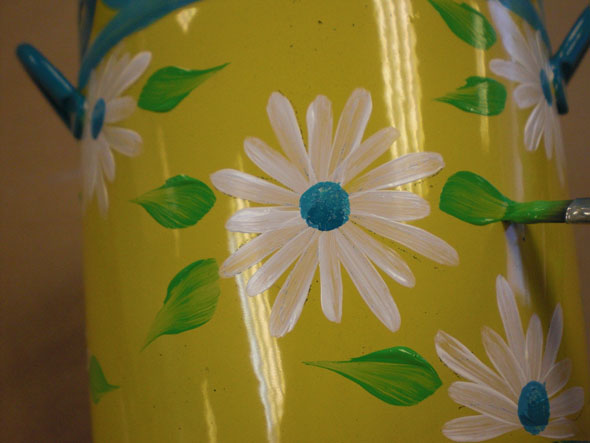
Accenting my painted tin pail with black will make it pop! So using my flat brush, I painted a Licorice checkerboard on the bottom Aqua band. I also painted Licorice horizontal line above the checkerboard using a liner brush.
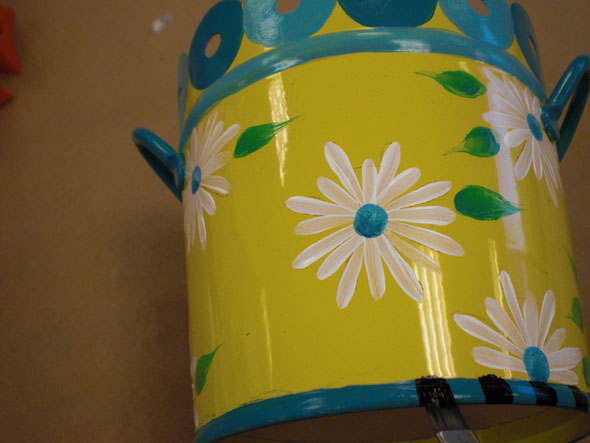
Still using the liner brush and Licorice, I embellished the leaves by adding veins and underlined each leaf.
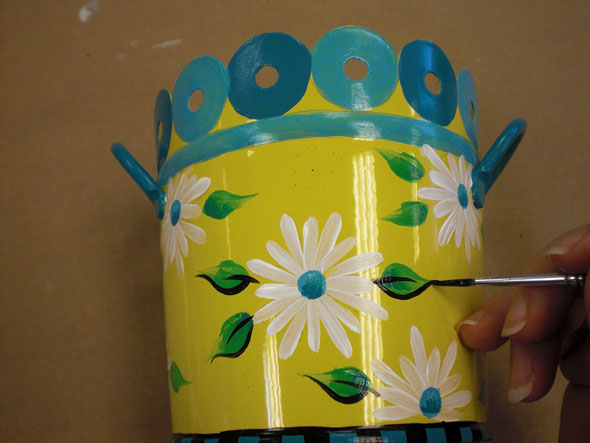
And of course, the daisies needed Licorice accents too! Using my stylus, I added tiny dots around each center.
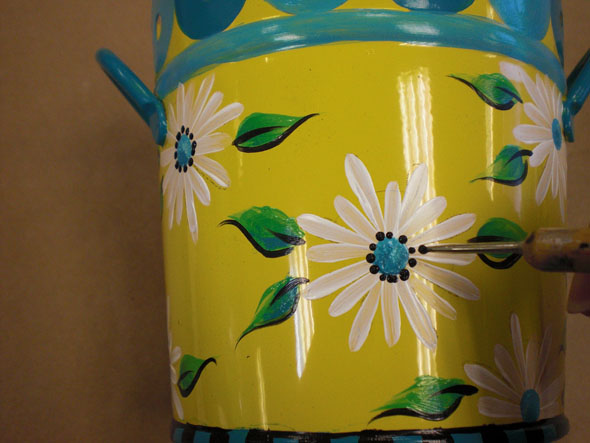
Next, I painted a Licorice checkerboard along the top Calypso Sky band and added polka dots to the handles. Don't you think the Licorice accents brought excitement and the project to life?

I then allowed the paint to dry and baked my project to cure the FolkArt Enamels paint. NOTE: Place the tin pail in a cold oven, set the temperature to 350 degrees and set the timer for 30 minutes. Turn the oven off and let both the oven and project cool down together. When completely cool, thread ribbon through the holes and tie a bow. Now isn't that loveliest painted tin pail? My painting brushes LOVE it!!
